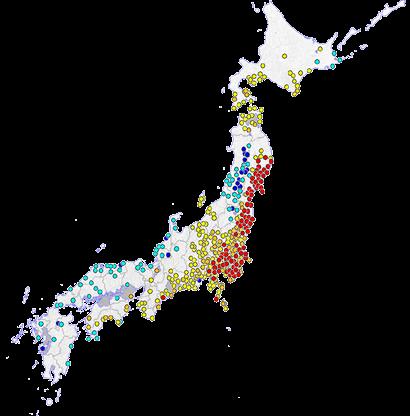
7 minute read
Recent Successes in Earthquake Predictions in Japan
Author:
Shunji Murai, Ph.D.
Advertisement
using daily data from the Global Navigation Satellite System (GNSS) observed by 1,300 GNSSbased control stations all over Japan is making waves and headlines. This approach was developed by a pioneering group of scientists who have been working on the method larger than Japan Meteorological Agency’s (JMA) seismic intensity scale 5 that were predicted successfully with the newly developed prediction method. Japan Earthquake Science Exploration Agency (JESEA) started its official efforts in earthquake prediction in February 2013, attractProfessor Emeritus, University of Tokyo Advisor, Japan Earthquake Science Exploration Agency
Anew approach for the earthquake prediction since 2002. Eight earthquakes occurred so far in 2014 with (JESEA)
ing more than 30,000 individual members who regularly receive weekly MEGA earthquake predictions. Due to the success of JESEA’s predictions, several TV programs and magazines have reported the agency’s achievements since May 2013.

Global Navigation Satellite System (GNSS) is a satellite system that is used to pinpoint the geographic location of a user's receiver anywhere in the world. Satellite-based navigation systems use a version of triangulation to locate the user, through calculations involving information from a number of satellites. Each satellite transmits coded signals at precise intervals. The receiver converts signal information into position, velocity, and time estimates. Using this information, any receiver on or near the earth's surface can calculate the exact position of the transmitting satellite and the distance (from the transmission time delay) between it and the receiver. Coordinating current signal data from four or more satellites enables the receiver to determine its position.
New Methods of Earthquake Prediction
Though the methods were relatively simple with the analysis of the daily data (a week data) observed at 1,300 GNSS stations and released every Monday by the Geospatial Information Authority (GSI).
JESEA developed and currently uses the following methods:
Weekly change: the change between the maximum and minimum height to be automatically checked to determine whether the change exceeds the threshold or not.
Two-year trend: the abnormal rising or sinking to be automatically checked.
Six-month accumulated deformation: accumulated value of rising or sinking to be automatically checked.
The above indices will then be represented in graph or map with respect to the prefecture category or all Japan. After checking the graphs and maps, careful interpretation for the prediction is executed. Professional experience and knowledge would be necessary for the prediction. Every word in the prediction document should be based on scientific back data or graphic representation.
Achievement of Predictions
Several cases of larger earthquakes occurred in 2014 are introduced hereafter together with the warning used in the mail magazine served to the individual members.
North Nagano Prefecture Earthquake
This earthquake occurred on the 22 November 2014 with magnitude of 6.7 and a Japan Meteorological Agency (JMA) scale of 6-. None died but about 30 houses were completely destroyed and about 60 houses were partially destroyed with about 50 persons injured. The first warning was made in the end of February 2014, reporting abnormal weekly height changes around the Nagano Prefecture area. In the beginning of May up to September 2014, the warning was upgraded to serious status as small earthquakes occurred more frequently near the area. Because a large earthquake occurred at the east end of the area in September and also Mt. Ontake Volcano erupted on the 27 September, the warning level was downgraded as careful status. But when a large earthquake occurred on the 22 November, the weekly magazine “Weekly Post” issued on the 8 September then reported the serious status of the area with a risk map. The prediction was treated as a successful case, which was reported in the weekly magazine issued on 1 December 2014.
Oshima Offshore Earthquake
This disaster occurred on the 5 May 2014 with a magnitude of 6.0 and JMA scale of 5-. Though the epicenter was near the Oshima Island, located south of Tokyo Bay, the most seriously affected area was Chiyoda Ward in central Tokyo. Since the depth of the epicenter was 160 km under the ground, the weekly height changes and two-year trend did not provide any pre-signals except only in the accumulated deformation. Figure 1 shows the abnormal signals in the accumulated deformation shown in a red circle. The image was reported to the JESEA members in the end of March 2014. From the beginning of April, JESEA began to warn the public of the possibility of earthquake in Tokyo area. It was about a month after the warning when the actual earthquake occurred.
Iyo-nada Earthquake
This earthquake occurred on the 14 March 2014 with a magnitude of 6.2 and JMA scale 5+. The pre-signals of the abnormal weekly height changes were identified in September and October 2013 and January 2014. JESEA started warning in October and continued providing detailed information for 13 weeks until the earthquake occurred. On the 9 March, a local Fiji TV program invited the leading expert to provide more clarity about this issue. It was then reported that a big earthquake would occur around Kyushu and Shikoku area (the epicenter of Iyonada included) within March. Five days after the TV program was broadcasted on the 9 March, the Iyo-nada Earthquake occurred on the 14 March. The precision of the predictions resulted in the drastic increase of subscriptions of individual members with 2,000 up to 10,000 applying for forecasts within a week.
x

Oshima Offshore Earthquake
Figure 1: Abnormal distribution of accumulated deformation in Tokyo Area. The epicenter, Oshima Island, is marked with an X but did not quake unlike central Tokyo which was affected seriously as shown in the figure on the right.
Iyo-nada Earthquake

Unlocking the Future Potential of GNSS
JESEA succeeded in the scientific prediction of earthquakes using GNSS data based on the time accuracy from the pre-signals until the occurrence of the corresponding earthquake with variations proving to be not very high, ranging from a few weeks to a few months. Though the governmental and academic organizations have yet to fully accept this new methodology, more than 30,000 individuals have already subscribed to receive the predictions from JESEA and this number is expected to increase in the coming months given the reported precision of the application of GNSS data.
Sources: Houston News
October 2015
AIT Consulting in collaboration with other innovative solution partners is organizing a two-day event in Bangkok on the theme “Housing for All: Innovative Solutions” later this year. This event will cover many aspects related to overcoming the housing challenges for providing affordable housing in many countries all over the world.
Rapid urbanization and increasing costs has made it extremely difficult for people with low income to afford and live in decent and healthy living spaces especially in urban and sub-urban areas. Lack of appropriate technologies to build sustainable and eco-friendly homes at an affordable price and appropriate mechanisms to create financial viability contributes to the increasing challenge.

In order to overcome some of these major challenges, AIT Consulting is organizing this event where a panel of key experts will present integrated and comprehensive solutions including financial and business models, suitable technologies and innovative ideas such that some of these challenges may be addressed. This event will be attended by government bodies, housing authorities and policymakers, INGOs and funding agencies, development agencies, real estate and private construction companies, financial institutions, engineers, architects, and other universities in the region.

The event will also showcase an exhibition of related products, services and appropriate technologies for providing affordable housing solutions.
Tentative Themes
1. Livability 2. Disaster Resilience 3. Environmental Sustainability 4. Construction Technologies 5. Reducing Costs 6. Increasing Affordability 7. Business and Commercial Viability 8. Social and Community aspects 9. Facility Management
STUDENT COMPETITION

Students from universities in Asia are invited to participate during this event. They will be challenged to develop innovative and appropriate solutions to address providing housing for all. Selected finalists will then prepare a presentation on their topic to be delivered during the event dates.
Competition Topics
Financial models
Innovative construction technology to build affordable housing Business model for providing affordable housing
For more information, visit: www.consulting.ait.asia
www.facebook.com/aitconsultingasia https://www.linkedin.com/in/aitconsultingasia
Increasing Disaster Resilience for Nepal’s School Sector
By Naveed Anwar

Due to Nepal’s susceptibility to natural disasters, the loss of human, economic, and education facilities after a strong event will be of an enormous scale. By increasing the disaster resilience of schools and its infrastructure, these consequences can be averted or reduced significantly.




